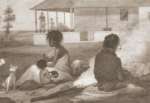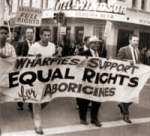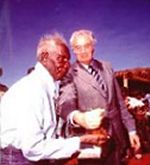|
click below for more about these issues
native
title Aboriginal
history and heritage Aboriginal
identity and culture australia's
human rights record reconciliation,
social justice, the constitution and a treaty the
stolen generations |
| information| issues Aboriginal
history and heritage

Dharug people in C18th Sydney | "Their
laws, especially with regard to marriage, are complex and wonderful. Their corroborees,
or festival dances, are very wonderful. Their sagacity, especially on the tracking
of men or cattle, is very wonderful. The skill with which they use the small appliances
of life which they possess is very wonderful. But for years, probably for many
centuries, they have made no progress, and the coming of the white man among them
has had no tendency to civilise - only a tendency to exterminate them.”
Anthony
Trollope 'Australia' | 
Dharug people today | With evidence of occupation over 60,000
years, the Aboriginal and Islander peoples of Australia may be the world’s
oldest people in the world’s oldest land. But their place in Australia’s
history is only now being properly acknowledged and recorded. By 1788 around
500 Aboriginal tribes or nations occupied the Australian landmass, with efficient
and sustainable systems for living off the land. They achieved a balanced diet
by hunting and gathering, moving seasonally between camps as food supplies dictated.
Fire was used methodically to burn old growth and encourage new. Being mobile,
possessions were minimal. They had complex religious beliefs, sophisticated social
relationships and trading links across the continent. In 1788 the first
European settlement - Britain’s latest penal colony - was established at
what is now Sydney. The effects were catastrophic. With the convicts, soldiers
and settlers came diseases to which Aboriginal people had no resistance - typhoid,
flu, smallpox and venereal disease. The next hundred years saw Aboriginal
people forced out of their country, dispossessed of habitable land, shot, poisoned
and massacred as successive waves of British settlers sought land for building,
agriculture, grazing and mining. Rape and abduction of Aboriginal women and girls
were common. Some tribes at first welcomed or tolerated the newcomers,
but as it became clear that the British intended to stay, conflict escalated.
Aboriginal groups mounted effective guerrilla campaigns but were eventually overwhelmed
by the new repeater rifle, horsepower and the armed might of colonial governments.
Removed from their land, deprived of their traditional bush food and devastated
by disease, malnutrition, poverty, alcoholism, violence and despair, most Aboriginal
people existed on town fringes and pastoral properties or were herded onto reserves
and missions. When through hard work they made these reserves into productive
agricultural holdings, that land too was seized. Little changed with Britain’s
transfer of power to a Federal Australia in 1900/1901 under the new Federal Constitution.
Until the 1960s Aboriginal people did not have effective citizenship and could
not vote. They were rigidly controlled by State laws. Many were confined to reserves
which they could not leave without a permit. The State was guardian of all Aboriginal
children and many were taken by force from their families to be raised (and abused)
in institutions. Aboriginal people fought in 2 World Wars and were essential to
the development of pastoral Australia, but were discriminated against in education,
health, jobs, pay and in buses, cinemas and swimming pools. But 200 years of
attempts to obliterate Aboriginal identity and culture failed. Aboriginal people
resisted through non co-operation, sabotage, protests, strikes, mutual help and
increased political activism. Finally in the middle of this century Aboriginal
and Islander people got the vote, citizenship, equal wages and inclusion in the
national census.

W harfies (dock workers) supporting equal wages, May Day march, Sydney 1965 |

Poster from 1967 referendum campaign | 
Prime Minister Gough Whitlam symbolically pours a handful of sand through Gurindji
elder Vincent Lingiari's hands at the handback of the Gurindj's traditional lands
in 1975 | Following a 1967 referendum, the Federal (Canberra)
Government gained powers to legislate on Aboriginal matters. Legislation opposing
racial discrimination was passed in 1975. In 1990 ATSIC was set up - elected Aboriginal
and Islander Regional Councils and a national Aboriginal and Torres Strait Islander
Commission, with civil service staff and limited budgets for regional and national
development programmes. Aboriginal-initiated health, housing and legal aid services
were set up to supplement inadequate Government provision. But at the beginning
of the 21st century, the struggle against disadvantage and inequality continues
- for recognition, land, self determination, jobs, adequate health, education,
water and power services, and an end to the incarceration and deaths of too many
Aboriginal people.
Further reading and links:
Some
clippings that we would highlight include:
- Aboriginal
cave paintings date back 4,000 years
2 July 8, 2003 - The Guardian (UK)
- Associated Press - A chance discovery by a hiker has been hailed as one of the
most significant finds of Aboriginal rock art in Australia's history - a cave
containing more than 200 paintings, some believed to be 4,000 years old. - Look
back in anger
4 January, 2003 - Faced with a government review, the National
Museum of Australia may be forced to reinterpret its controversial portrayal of
the nation's colonial history, writes Joyce Morgan. The federal Arts Minister,
Richard Alston, made a curious qualification when he referred to the National
Museum of Australia last month. He told Parliament the establishment of the museum
had been a good outcome, "certainly in terms of the structure of the building".
- Landscapes in blood
14 December,
2002 - The Aborigines of the Kimberley have turned to pictures to sway the debate
about white massacres of their people. 'He ran and ran. The white men were chasing
him on horseback and he hid in the water. A white man shot at him from up on the
horse. The old man thought quickly and cut himself so that his blood came out
in the water. The white man looked at it and said: 'All right. I hit him."'
- Truganini's spirit felt by visitor to her
land
14 February, 2002 - The wild landscape where Truganini once walked
is playing its part in the campaign for British museums to send home the human
remains in their collections. - Admired by Macquarie,
but ignored for a sailing cat
11 May, 2002 - Funny mob, Australians. They
make more fuss over a cat than a king. This weekend marks the 200th anniversary
of Matthew Flinders signing up King Bungaree, last tribal chief of the Broken
Bay Aborigines, to help in the first circumnavigation of the continent Flinders
was to call Australia. - Forgotten Aborigine
team who changed cricket forever
8 March, 2002 - Guardian (UK) - They
were cricket's forgotten heroes - a team of Aborigines who came to England in
1868 viewed as little more than a joke, and ended up changing the face of cricket
forever. Now a previously unseen archive of photographs, scorebooks and other
memorabilia chronicling the first - and last - tour by native Australians has
surfaced after languishing in an attic for more than 80 years. - Aborigines
offer alternative guide to their land
11 July, 2001- The Independent
(UK) - "There she goes," said Lino Thomas, peering through the drizzle
at the mist-veiled mountain rising ahead. "Look at that grey cloak. She's
wearing her possum skin again." Ms Thomas, an Aboriginal tour guide, was
pointing to one of the earliest landmarks recorded by Captain Cook as he sailed
up the coast of southern New South Wales. Cook called it Mount Dromedary, but
the mountain already had a name: for thousands of years, Aborigines had known
it as Gulaga. - Pieces in the 'Puzzle' of Australia
9 June, 2001 - International Herald Tribune - The brand new National Museum of
Australia here has brought together, for the first time, the story of Aboriginals
with the cultural history of the European settlement of Australia. - Debate
rages over "peaceful" white settlement
16 April 2001 - Tony
Jones speaks with Henry Reynolds and Keith Windschuttle. Henry Reynolds is one
of Australia's most influential historians, who's responsible for some of the
most comprehensive and original research, documenting the violence on Australia's
frontier. He's written nine books and is presently a research professor at the
University of Tasmania. Historian Keith Windschuttle's recent series in the conservative
magazine 'Quadrant' attacked the work of Henry Reynolds and others. He's also
the author of 'The Killing of History', how literary critics and social theories
are murdering our past and he's the publisher of Macleay Press. - Guilt
surfaces at Australia's centenary
31 December, 2000 - The Independent
(UK) - When proud Australians paraded through Sydney 100 years ago tomorrow to
hail the birth of their independent nation, there were no black faces among the
marchers, or the hat-waving crowds. There were, for that matter, only two women
in the procession. - A Black Day in London
8 July, 2000 - In the British Parliament, a Labour MP, Mr Jeremy Corbyn, tabled
a motion calling on "the governments and peoples of Australia to mark the
Centenary of Federation by committing themselves to redress discrimination and
disadvantage" of Aborigines. - Aboriginal
and Islander history: An introduction


read
about:
|| click
to go to the top of this page | |
European languages

You can make a difference

Support
the Stolen
Wages campaign. From 1904 to 1987, the Queensland Government withheld
or underpaid wages earned by Aboriginal workers; a fraction has been offered as
a settlement. Your
assistance would be greatly appreciated
››
Latest |
 info
for aborigines on European info
for aborigines on European
campaigning
 ENIAR
Bulletin Board ENIAR
Bulletin Board
You can make a difference

Aboriginal
life expectancy is twenty years less than other Australians. Indigenous infants
die at the same rate as those in impoverished countries.
›› Support
the Healing Hands Indigenous
Health Rights Campaign. |
|